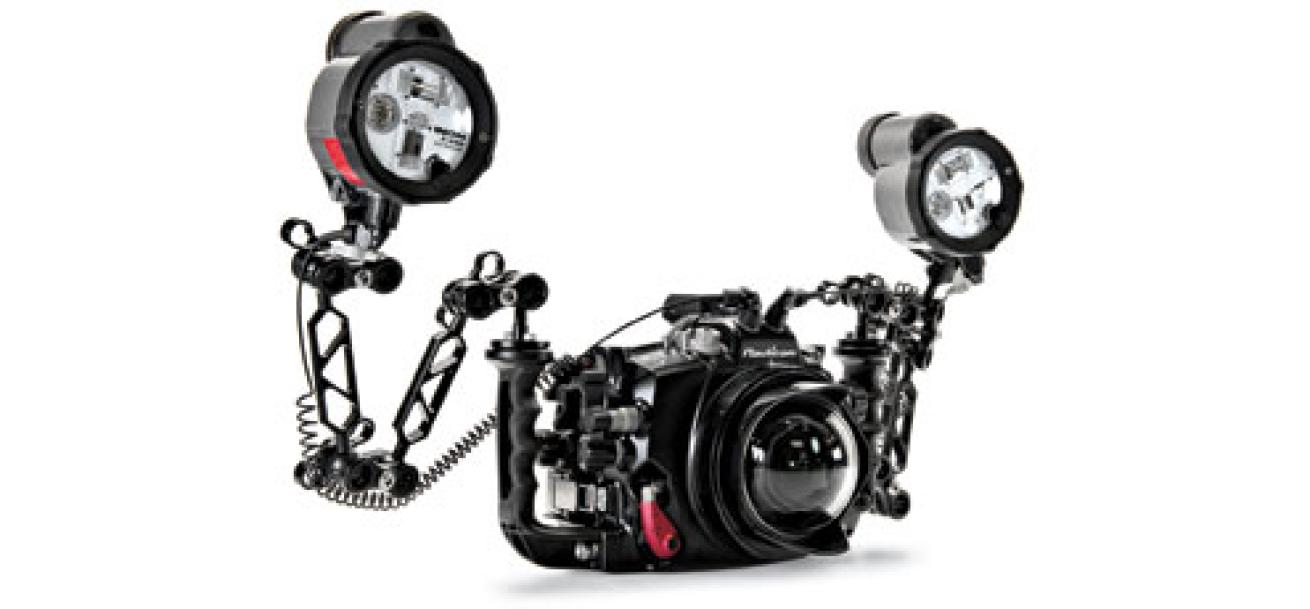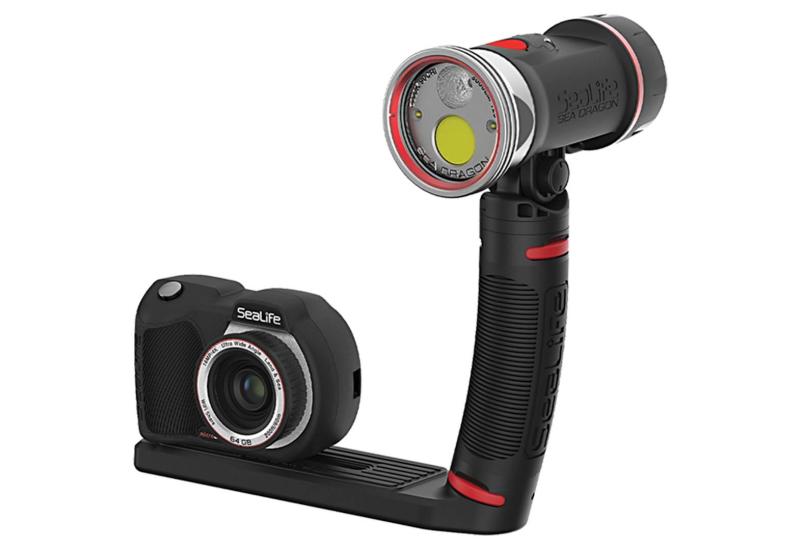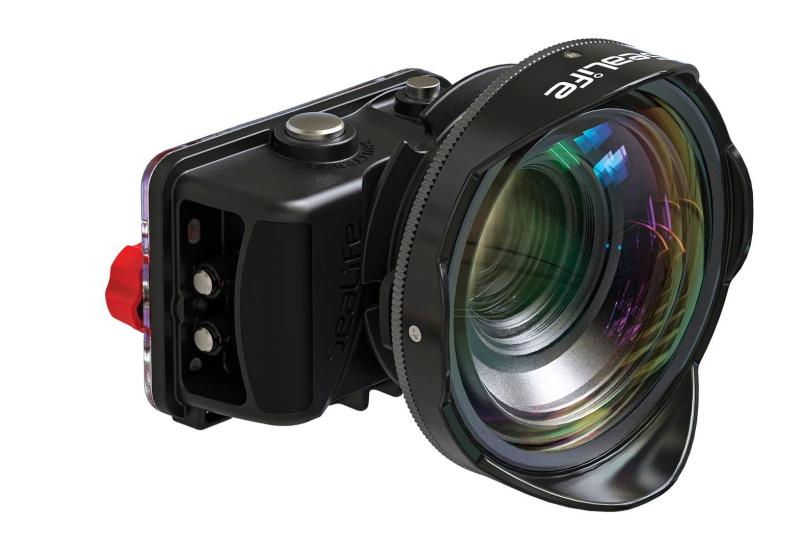ScubaLab: Underwater Camera Systems - Nauticam for the Canon 7D

Specifications
| Sensor | 18 MP, 22.3x14 mm, APS-C CMOS |
| Image Size | Large RAW: 5,184x3,456, to 2,592x1,728 at lowest JPEG resolution |
| Sensitivity | ISO 100-12,800 |
| Image File Formats | JPEG, RAW, M-RAW, S-RAW |
| Auto Focus | 19-point cross-type, with a range of user-controlled optimizations, plus new Focus Color Luminance metering system |
| Exposure Modes | Multiple |
| White Balance | 9 presets including Manual, plus white-balance shift |
| Weight | 1.8 pounds |
| Monitor | 3-inch, 92,000 pixel LCD with a viewing angle of 160 degrees, with ambient-light brightness-adjustment sensor |
| Zoom | Dependent on Lense |
| Video Mode | 1080p HD (24, 25 and 30 fps); 720p (50 and 60 fps) |
| Special Features | Multiple pro-level features with many levels of customizable image control and processing systems |
| System as Tested | Nauticam NA-7D housing, Canon 7D camera, two Inon Z-240 strobes. Used two separate lenses: the Tokina 10-17 mm lens with a Zen DP-100 4-inch dome port and, for macro, a Canon 60 mm lens with Nauticam N60G macro port. |
| Price as Tested | $8,157 |
| www.canon.com | |
| www.nauticam.com |
The Pros Say
The Nauticam NA-7D complements the powerful Canon 7D with ergonomic button placement and features that underwater photographers will benefit from, like the rope handle for ease of passing the system in and out of the water. This camera system is for the advanced underwater photographer who is willing to invest time and money in a system that has the capability to produce award-winning results.
The Test Diver Says
To start, the grips on this system are great, both comfortable and sturdy. Despite the weight, I felt in complete control of the housing at all times — even in heavy surge or while inverted. The housing is negatively buoyant and can get heavy toward the end of a long dive or if you need to swim a long distance. With the dual strobes, the housing also tends to lean forward, but the beefy grips help balance all that out. The housing feels solid and completely functional. It looks and seems bulletproof, giving the photographer a sense of security having such a high-end camera locked inside. The zoom knob is big and easy to grip with two fingers while gripping the handle. However, it is a bit stiff and can be a little hard to turn, which took a little getting used to. If it offered a little smoother action it would be perfect. I found it very easy to switch between modes with the touch of a button or a turn of a knob. The review features are outstanding. The LCD is big and easy to see while underwater, even when diving in less-than-ideal conditions. I think you could be in a muddy lake and still enjoy reviewing your shots. Scrolling through the photos and deleting is simple, fast and easy. Safety stops will never be boring with this setup. The placement and functionality of the auto focus and shutter buttons is phenomenal. With your thumb and finger, focusing and shooting are easy and become second nature, which is great when trying to capture that split-second shot. Switching from photo to video is the easiest and quickest I have ever seen. Without even taking your eye off the viewfinder or live view, you can switch from photo to video and back instantaneously. The buttons and switches are easy to locate and use in a hurry. Buttons and knobs are all solid and smooth: each one depresses easily even with thick neoprene gloves on. The only knob that I found a bit difficult to use was one of the most important ones. The knob that adjusts either your f-stop or shutter speed (depending on the mode you’re shooting in) was stiff and a little awkward to adjust if you are gripping both handles and looking through the viewfinder. This was probably the only real complaint I had. On the other hand, the port locking system is second to none. Swapping out ports in between dives is fast and easy. The locking system gives the photographer an overwhelming feeling of security. The extender viewfinder makes it extremely easy to focus and frame your subject. Switching to the live view is great. The giant LCD screen comes in handy with trying to get those odd-angled shots. Shooting in macro was like another level of photography. The attached focus light and external magnifier added another dimension to an already great photographic experience. I found removing the backplate of the housing and inserting and removing the camera easier than I ever thought possible. This is great when you want to switch lenses and dome ports in between dives and don’t want to spend your entire surface interval doing so. Overall, this system was everything I could ever ask for or expect from an underwater housing. The entire setup was intuitive and easy to use. It is designed with functionality and durability in mind. After spending a weekend in the water with this system, I wouldn’t hesitate for a second to recommend a Nauticam housing to anyone considering a housing for his or her DSLR. — Jeff Lovin
| August 2010 Issue Scuba Lab Review Quick Links |
|---|
| Optical Cameras |
| --- |
| Canon Powershot D10| Fisheye Fix for the Canon G11 |
| Fisheye Fix for the Canon S90| Sea&Sea; DX-2G |
| Bonica for the Sony T90| |
| Micro Four-Thirds Camera |
| --- |
| Olympus PT-EP01 for the E-PL1 |
| Digital SLR Cameras |
| --- |
| Ikelite for the Nikon D90| Nauticam for the Canon 7D |

Specifications
| Sensor | 18 MP, 22.3x14 mm, APS-C CMOS |
| Image Size | Large RAW: 5,184x3,456, to 2,592x1,728 at lowest JPEG resolution |
| Sensitivity | ISO 100-12,800 |
| Image File Formats | JPEG, RAW, M-RAW, S-RAW |
| Auto Focus | 19-point cross-type, with a range of user-controlled optimizations, plus new Focus Color Luminance metering system |
| Exposure Modes | Multiple |
| White Balance | 9 presets including Manual, plus white-balance shift |
| Weight | 1.8 pounds |
| Monitor | 3-inch, 92,000 pixel LCD with a viewing angle of 160 degrees, with ambient-light brightness-adjustment sensor |
| Zoom | Dependent on Lense |
| Video Mode | 1080p HD (24, 25 and 30 fps); 720p (50 and 60 fps) |
| Special Features | Multiple pro-level features with many levels of customizable image control and processing systems |
| System as Tested | Nauticam NA-7D housing, Canon 7D camera, two Inon Z-240 strobes. Used two separate lenses: the Tokina 10-17 mm lens with a Zen DP-100 4-inch dome port and, for macro, a Canon 60 mm lens with Nauticam N60G macro port. |
| Price as Tested | $8,157 |
| www.canon.com | |
| www.nauticam.com |
The Pros Say
The Nauticam NA-7D complements the powerful Canon 7D with ergonomic button placement and features that underwater photographers will benefit from, like the rope handle for ease of passing the system in and out of the water. This camera system is for the advanced underwater photographer who is willing to invest time and money in a system that has the capability to produce award-winning results.
The Test Diver Says
To start, the grips on this system are great, both comfortable and sturdy. Despite the weight, I felt in complete control of the housing at all times — even in heavy surge or while inverted. The housing is negatively buoyant and can get heavy toward the end of a long dive or if you need to swim a long distance. With the dual strobes, the housing also tends to lean forward, but the beefy grips help balance all that out. The housing feels solid and completely functional. It looks and seems bulletproof, giving the photographer a sense of security having such a high-end camera locked inside. The zoom knob is big and easy to grip with two fingers while gripping the handle. However, it is a bit stiff and can be a little hard to turn, which took a little getting used to. If it offered a little smoother action it would be perfect. I found it very easy to switch between modes with the touch of a button or a turn of a knob. The review features are outstanding. The LCD is big and easy to see while underwater, even when diving in less-than-ideal conditions. I think you could be in a muddy lake and still enjoy reviewing your shots. Scrolling through the photos and deleting is simple, fast and easy. Safety stops will never be boring with this setup. The placement and functionality of the auto focus and shutter buttons is phenomenal. With your thumb and finger, focusing and shooting are easy and become second nature, which is great when trying to capture that split-second shot. Switching from photo to video is the easiest and quickest I have ever seen. Without even taking your eye off the viewfinder or live view, you can switch from photo to video and back instantaneously. The buttons and switches are easy to locate and use in a hurry. Buttons and knobs are all solid and smooth: each one depresses easily even with thick neoprene gloves on. The only knob that I found a bit difficult to use was one of the most important ones. The knob that adjusts either your f-stop or shutter speed (depending on the mode you’re shooting in) was stiff and a little awkward to adjust if you are gripping both handles and looking through the viewfinder. This was probably the only real complaint I had. On the other hand, the port locking system is second to none. Swapping out ports in between dives is fast and easy. The locking system gives the photographer an overwhelming feeling of security. The extender viewfinder makes it extremely easy to focus and frame your subject. Switching to the live view is great. The giant LCD screen comes in handy with trying to get those odd-angled shots. Shooting in macro was like another level of photography. The attached focus light and external magnifier added another dimension to an already great photographic experience. I found removing the backplate of the housing and inserting and removing the camera easier than I ever thought possible. This is great when you want to switch lenses and dome ports in between dives and don’t want to spend your entire surface interval doing so. Overall, this system was everything I could ever ask for or expect from an underwater housing. The entire setup was intuitive and easy to use. It is designed with functionality and durability in mind. After spending a weekend in the water with this system, I wouldn’t hesitate for a second to recommend a Nauticam housing to anyone considering a housing for his or her DSLR. — Jeff Lovin
| August 2010 Issue Scuba Lab Review Quick Links |
|---|
| Optical Cameras |
| --- |
| Canon Powershot D10| Fisheye Fix for the Canon G11 |
| Fisheye Fix for the Canon S90| Sea&Sea; DX-2G |
| Bonica for the Sony T90| |
| Micro Four-Thirds Camera |
| --- |
| Olympus PT-EP01 for the E-PL1| |
| Digital SLR Cameras |
| --- |
| Ikelite for the Nikon D90| Nauticam for the Canon 7D |










